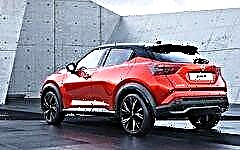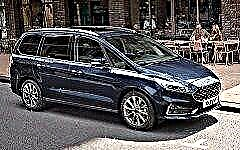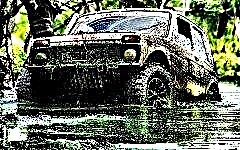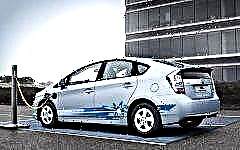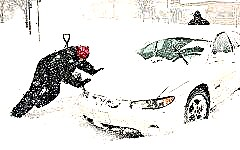

The content of the article:
- Five simple rules to keep in mind
- Don't decrease (increase) your cravings
- Do not use hard braking
- Don't skid trying to get out
- Do not apply the brake when cornering
- Don't forget about the light
Winter is a test time for drivers who got their license in the summer. The first ice is fraught with drifts, minor unpleasant accidents. In winter, almost every tenth kilometer you can see an accident, and it's good if it's small. The point is not at all that it suddenly got colder and did not have time to change summer tires - on a winter road you cannot make sudden movements, everything should happen smoothly, measuredly, without nervous twisting of the steering wheel.
To avoid major accidents, you need to have simple driving skills on a frozen track. On a winter road, you need to radically change your driving style. In order to avoid unpleasant situations, you need to remember a few rules about how not to behave on a snowy road.
Five simple rules to keep in mind

- Don't decrease (increase) your cravings;
- Do not use hard braking;
- Do not skid when trying to get out;
- Do not apply the brake when cornering;
- Don't forget about the light.
By keeping these rules in mind, the chances of avoiding an accident will increase significantly. Let's take a closer look at each rule.
Don't decrease (increase) your cravings

The drive wheels, no matter front or rear, must be subject to constant traction. With a sharp increase in the drive traction, the car will certainly skid on a snowy or icy road - this should not be done in any case, the traction must be kept at the same level constantly. It is easier to do this with a manual transmission.
If you need to increase traction, you need to do it smoothly and without sudden jumps, otherwise you will not be able to hold the car, and it will go into free sliding.
Do not use hard braking
On the driving wheels, constant traction must be maintained - rolling along the coast, as in the summer, can result in a skid. The roll-over is very dangerous on an icy road.
Front-wheel drive cars when starting off behave better on slippery roads, but with emergency braking, the rear of the car turns out, overtaking the front. The driver does not consciously apply the brake, which leads to greater skidding, since only the front wheels brake, and the rear wheels are in uncontrolled rotation. Conclusion: do not drive, do not make sharp turns, all movements should be smooth.
A rear wheel drive car is more difficult to handle on slippery roads. On such a car, you need to be doubly careful - any sudden movement by the steering wheel, and it has already been carried over the ice. Here you need to strictly keep the speed limit. As the saying goes, "you drive quieter, you will continue." The proverb fits perfectly with the rules for driving rear-wheel drive cars in the winter season. If you have already suffered, just take your foot off the gas, do not brake, and turn the steering wheel in the direction of the skid. The car will turn around and it will stop. After stopping, you can begin to taxi to the desired trajectory.
Sudden braking, even at low speed, is no less dangerous than speeding. Keep a close eye on the situation in front and behind.
Do not be distracted by extraneous things - at any moment the car driving in front of you can skid, and you will have to urgently take measures to avoid a collision.
Braking on slippery surfaces should be smooth. Do not close the distance, even at traffic lights, keep it at the required level.
Too great a distance is even more dangerous - someone can wedge in between you and the front car and create an emergency situation, while you can be made guilty, and with our morals, even beaten right there on the road.
Don't skid trying to get out

It is very easy to drive off a slippery slope from a parking lot or from a heavily dusted parking lot, if you do not skid in vain.
It's good to climb uphill in a rear-wheel drive car. When lifting, the load is mainly on the rear suspension, so they hardly slip. Front-wheel drive, on the other hand, skips more often on the rise, since the grip of the front wheels with the road is weaker than the rear.
If you are stuck while trying to leave, do not squeeze the gas pedal at full power, it will only get worse. Even if you have expensive studded tires, it will not help you - you dig deeper into the snow, and there will be less chances to get out. If you skid frequently, even the best tires will become bald, slippery and unsuitable for winter roads.
It is better to leave by the "swing" method. Do not twist the steering wheel to the side at a large angle - this can get stuck tightly, and then you cannot do without outside help. As soon as the car drives through the snow, shift into second gear. Do not accelerate, drive slowly, gradually picking up speed. Do not turn the steering wheel unnecessarily, otherwise the car will skid.
Many people think that the deeper the treads of winter tires, the better the grip, but this is a misconception - it is better to choose tires with a shallow but frequent pattern, twisting in different directions. The most reliable for driving on ice is studded tires. Metal studs cut into the ice for a secure grip. But if you slip often, little will remain of the spikes. It is better to learn to get out of the "ambush" by swinging the car back and forth, and by inertia jump off the problematic section of the track. It will be much faster and will not damage the rubber.
Do not apply the brake when cornering

Remember the speed limit. If, when entering a corner at high speed, on the front-wheel drive car you release the gas, you can send it into an uncontrolled slide along the highway. Where the car will carry is impossible to predict. If the road is clear, it is better to drive a little into the oncoming lane and smoothly return to your lane.
Harsh braking when cornering is used by many drivers, which often leads to accidents. On a straight road, such braking is less dangerous than in a corner. Reduce speed a few meters before turning. Keep your distance, if someone is in a hurry behind - skip. Correctly selected speed mode is a guarantee of safety, because in winter the braking distance is greatly increased. When the situation leaves no room for avoiding a collision, it is better to drive into a snowdrift on the side of the road than into the back of the car in front.
In ice, in general, the brake pedal must be used very carefully, otherwise, instead of braking, you will get a completely opposite effect. On an icy track, it is better to brake with a motor - release the gas pedal and not very intermittently press the brake. Only by slowing down slightly can you avoid heavy skidding.
Don't forget about the light

The light must be on at any time of the day. In winter, driving without parking lights is akin to walking along the edge of an abyss in pitch darkness. Even if the track is illuminated by roadside lights, driving with the headlights off or, worse, completely inoperative, is prohibited. In winter it gets dark early, dawn late. In inclement winter weather and during daylight hours, a car without headlights can be seen only 5-10 meters before the collision, and in dusk and a couple of meters away. That is why the requirement to drive with the headlights on, even during the day, was included in the traffic rules.
Keep your headlights clean - dirty headlights shine much worse. Replace burnt out light bulbs in time. Do not put xenons on - they greatly blind the drivers of oncoming cars, even if the dipped beam is on.
On a slippery road, it is especially dangerous to exceed the speed, overtake, in your opinion, other motorists slowly crawling. Be careful and attentive on the road. Do not be distracted by the phone - in dangerous areas you need to be as focused on the movement as possible.There is no need to drive a car with one hand, showing your professionalism - you may make an impression on your companion, but as an option, you can provoke a minor accident.
Of course, experienced drivers will find these rules completely useless, but judging by the current traffic situation, there are not so many experienced motorists. Be attentive on the roads, follow the rules, respect other drivers. And, as they say, "neither a nail, nor a rod" is on your way.


